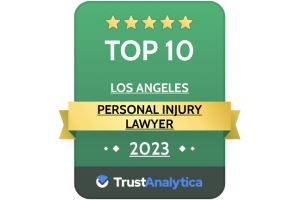- Free Consultation: 866-966-5240 Tap Here To Call Us
Lyft Accused of Enabling Sexual Assault in California Lawsuit

Ride-share apps have transformed how people in California and elsewhere hail rides. Instead of calling and scheduling a taxicab, people simply have to download an app to be connected to any number of nearby Lyft or Uber drivers who are near to them. When these apps emerged on the scene in 2010, they quickly became popular. While the companies ostensibly conduct background checks of their drivers, however, many riders have reported that they were sexually assaulted by ride-share drivers. Recently, 14 people filed a lawsuit against Lyft in San Francisco, alleging that they were raped by their drivers.
Lyft lawsuit alleges rapes by drivers
The 14 plaintiffs in the lawsuit all allege that they were raped or sexually assaulted by their Lyft drivers. One plaintiff stated that she was raped in Oct. 2018. Her driver drove her around for five hours with the doors locked before forcibly raping her on a beach. Another states that she was sexually assaulted in Dec. 2018. She reported the assault to Lyft, and Lyft said it would investigate. However, she never received an update from the company and does not know the status of the driver’s employment with the company.
The attorneys for the plaintiffs say that they found evidence of 100 rapes and sexual assaults by Lyft drivers in California over 18 months. Through the lawsuit, the plaintiffs are seeking several changes. They want Lyft to install cameras in their driver’s cars. The plaintiff who was raped on the beach said a camera would have shown the driver snatching her phone away and climbing into the back seat. Other changes that the plaintiffs are asking to be implemented include mandated reporting by Lyft of sexual assault complaints that it receives. The plaintiffs allege that Lyft covered up many sexual assault complaints and never reported them to law enforcement for criminal investigations.
The plaintiffs also want Lyft to install safety features on its app that would alert the company when its drivers are behaving suspiciously. Finally, the plaintiffs want Lyft to have to use fingerprint background checks of its drivers and point to the example of Orlando Lazo, who is known as the ride-share rapist. Lazo reportedly used a false name when he applied as a driver and subsequently raped four passengers. If he had been forced to submit to a fingerprint background check, he would not have passed it and would never have been allowed to drive for the app.
Legal claims against Lyft: Vicarious liability
The legal claims against Lyft could include vicarious liability claims and negligent hiring, supervision, and retention claims. Under a legal liability doctrine known as respondeat superior, employers are generally liable for the negligent or wrongful acts of their employees when the employees are acting within the scope and course of their jobs. For this type of legal claim, plaintiffs do not have to show that the employer engaged in any improper or negligent acts. The employer’s actions are not relevant as a defense against vicarious liability. However, the plaintiff must be able to prove that the driver was working within the scope and course of his or her employment, which is where Lyft’s typical defense arguments come into play.
Lyft commonly argues that its drivers are independent contractors, meaning that there is no employer-employee relationship. If Lyft is successful with this argument, it may be able to avoid vicarious liability. Lyft also often argues that its drivers cannot be acting in the course and scope of their employment since there is no employment relationship.
There has not been a clear definition of what an independent contractor is. In Dynamex Operations West Inc. v. Superior Court, 4 Cal. 5th 903 (2018), the California Supreme Court established a stringent three-part test for determining whether a worker is an independent contractor or should instead be classified as an employee for wage determinations. In that context, the Supreme Court adopted the ABC test. Under this test, there is a presumption in favor of finding that the workers are employed. The defendants can overcome this presumption by demonstrating the three following factors:
- The worker operates independently and outside of the company’s control and direction in the performance of his or her job in both contract and in fact;
- The work performed by the worker falls outside the normal course of the company’s business; and
- The worker is normally engaged in an independent occupation or trade of the same nature as the type of work that he or she performs.
Lyft has tried to get around these factors by arguing that it is simply a platform or broker through which drivers and passengers can arrange rides. With this argument, it argues that it is a technology company, meaning that driving is not a normal course of its business. This argument has had mixed results.
Recently, the California Legislature passed Assembly Bill 5, which has been sent to Gov. Newsom for his signature or veto. This bill would extend the narrow holding in Dynamex beyond simple wage determinations and is aimed at ride-share companies like Lyft and Uber. If this bill is signed into law, it could ostensibly force Lyft, Uber, and other ride-share companies that operate in California to classify all of their drivers as employees. The companies state that they will continue to classify their drivers as independent contractors despite the law, setting the stage for future litigation.
Legal claims against Lyft: Negligent hiring, retention, and supervision
In contrast to respondeat superior and vicarious liability, claims of negligent hiring, retention, and supervision argue that the employer’s negligent acts or omissions that cause or contribute to the negligent or wrongful acts of their employees can provide grounds for the employers to be sued directly. For these types of claims, the plaintiffs must show that the defendant knew or should have known that the driver was unfit, unqualified, or dangerous, and foreseeable harm or injury could result.
In the context of the lawsuit against Lyft, the plaintiffs are arguing that the bare-bones background checks of the drivers are not enough to determine that they are qualified and fit to drive. As in the case of the ride-share rapist, the implementation of a fingerprint background check would have shown that the driver was dangerous and unfit to drive for the ride-share app. In these types of claims, plaintiffs’ lawyers use the past acts of the employee to demonstrate that he or she was unfit, dangerous, or unqualified against the employer. When Lyft fails to conduct fingerprint background checks of its drivers, it could be found to have negligently hired those who have criminal pasts.
Foreseeability of the sexual assault or rape will also likely be a point of contention. The company may argue that it was not reasonably foreseeable that an individual driver would commit a sexual assault or rape. This type of determination is fact-specific. However, if a particular worker has engaged in a similar act in the past, the harm caused by the recent act will generally be determined to be reasonably foreseeable.
In this case, the plaintiffs’ lawyers state that they have identified 100 sexual assaults and rapes in an 18-month period that were reported to Lyft and that Lyft reportedly failed to report to the police. This type of evidence can also be used to show that sexual assaults and rapes by the drivers are reasonably foreseeable because of the sheer frequency of their occurrences.
Get help from an experienced sexual assault attorney in Los Angeles
Rape and sexual assault claims against Lyft, Uber, and other ride-share companies may involve multiple legal claims. These companies typically try to argue that the drivers were not their employees and that their background checks are sufficient to avoid claims of negligent hiring and retention. An experienced attorney understands the types of arguments that are frequently raised and how to combat them. Contact an attorney at Steven M. Sweat Personal Injury Lawyers to schedule a consultation by calling us at (310) 592-0445.












